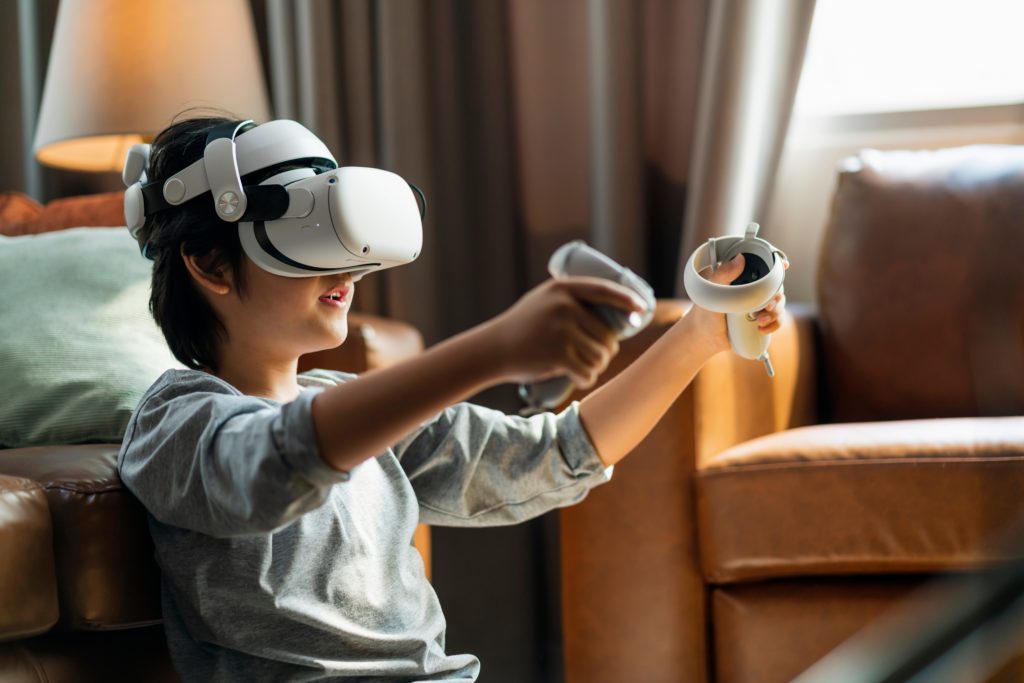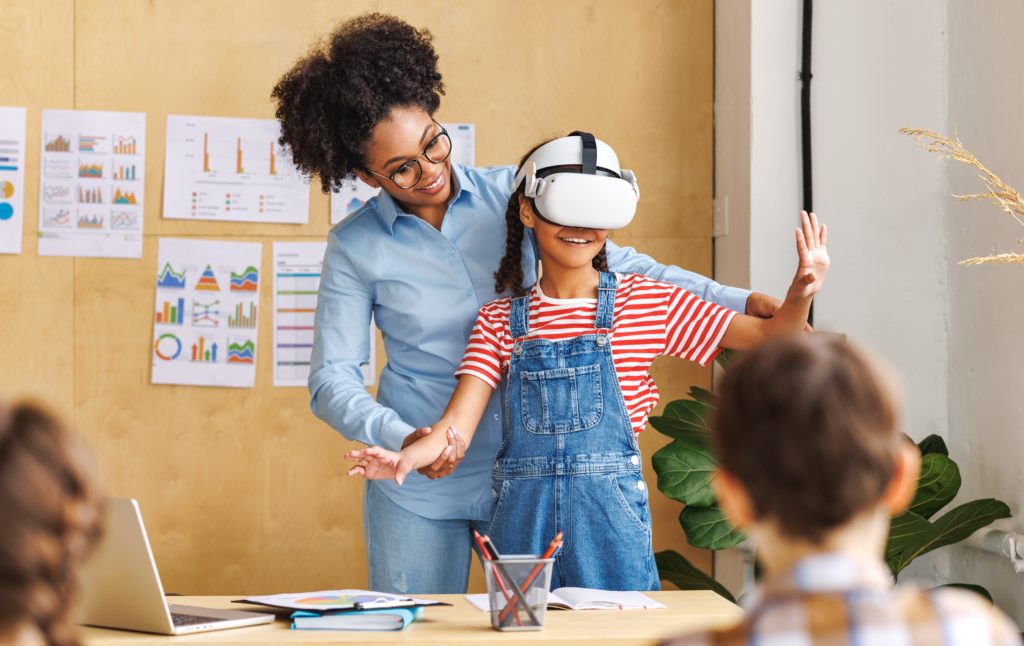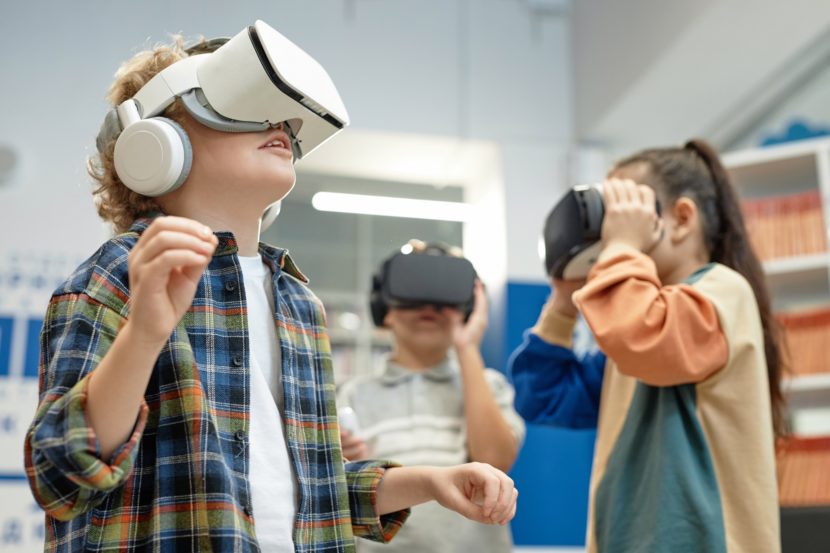Virtual reality (VR) technology has rapidly evolved, offering immersive experiences that blur the lines between the digital and physical worlds. As VR becomes popular, especially in the United States, it raises questions about its impact on children’s rights. This growing use of VR presents opportunities and challenges for children’s well-being and development.
What is virtual reality, and how does it affect children’s rights?
VR refers to computer-made environments that people can explore and interact with using a VR headset. This technology makes virtual spaces feel real by creating an immersive sense of presence (SkoolOfCode, n.d.).
VR can be used in schools to make learning more interactive, in healthcare for therapy, and in entertainment to level up gaming experiences. While VR supports children’s rights, such as access to education and health and the right to leisure, it also raises concerns about privacy, safety, and online risks, which could violate their right to protection if not properly managed.
VR adoption is on the rise, especially among American teens. As of 2024, nearly one in three teens owns a VR headset (Smith, 2024).
Positive impacts of VR on children
Educational opportunities
VR offers educational benefits by engaging students in ways that traditional methods cannot (Gossett, 2023). It allows students to experience virtual field trips and simulations that make learning more dynamic and interactive (Quaid, 2015). VR also prepares students for a tech-driven future, sparking creativity and curiosity (AME Group, n.d.).
Tools such as Google Expeditions and ClassVR provide immersive learning experiences in subjects such as history and science (Quaid, 2015; Suter, 2024). ClassVR has been gaining popularity, particularly in U.S. schools such as those in the Los Angeles Unified School District (eSchool News, 2024).
Gaming
VR offers immersive and interactive gaming experiences that go beyond traditional video games. Games such as Beat Saber and Dance Central encourage physical activity, helping children stay active while having fun. VR gaming also supports social development. Multiplayer games such as Rec Room promote teamwork, communication, and problem-solving skills. Platforms such as Harmonix Music VR also allow teens to create 3D drawings and choreograph dance moves, making VR a space for both relaxation and self-expression (Siejca, 2024).
Therapeutic applications
VR technology is increasingly used in therapeutic applications for children facing medical challenges. At Lucile Packard Children’s Hospital Stanford, VR helps distract young patients during painful procedures (DeTrempe, 2017). It also reduces stress for children in long-term hospital care by offering an escape from the hospital environment and assists children with disabilities or injuries while receiving physical therapy (Horiachko, 2024; SkoolofCode, n.d.). VR is also used in hospitals such as Children’s Hospital Los Angeles and Stanford Medicine to alleviate patients’ pain and anxiety during treatments (Children’s Hospital Los Angeles, 2021; Rollo, n.d.).
Social interactions
VR is opening up new social opportunities for children and teenagers, allowing them to interact with peers from around the world in virtual spaces such as VRChat and AltspaceVR. This avenue became especially important during the COVID-19 pandemic when VR provided an alternative way for young people to socialize (Maloney, 2020). VR is also helping children with autism spectrum disorder practice their social skills. Programs such as VOISS (“Virtual reality Opportunities to Integrate Social Skills”) allow children to simulate real-life situations, giving them the chance to practice social interactions and build confidence (Humphrey, 2021).
Negative impacts of VR on children
Exposure to harmful content
Young people can encounter harmful content and behaviors in VR, such as hate speech, bullying, harassment, and exposure to unwanted violent or sexual content on platforms such as VRChat. A study published in 2024 by Florida Atlantic University found that over 44% of U.S. youth in the metaverse received hate speech or slurs, with 8.9% encountering it frequently. Additionally, 37.6% reported bullying, and 35% experienced harassment (Galoustian, 2024).
Privacy concerns
Privacy is a major concern in VR environments, as these platforms collect vast amounts of data, which may reveal sensitive details about children. When children use VR, headsets track data on their eye gaze, voice, facial expressions, physical responses, and surroundings (Klein, 2022). This tracking raises privacy concerns, as the data may be used to infer personal details such as age, gender, and location (Smith, 2024). Besides, more than half of the VR devices lack parental controls, and some have no safety settings (Klein, 2022).
Physical and mental health concerns
Prolonged VR use can lead to eye and neck strain and vision issues in children due to the constant proximity of screens (Milovidov, 2023). They may also experience sickness, dizziness, and disorientation while using VR headsets (Scovell, 2023). In addition, VR can affect children’s social development, emotional well-being, and cognitive growth, leading to isolation and anxiety (Kaimara et al., 2021). VR use may also increase aggressive behavior and the risk of addiction (Common Sense, 2018).
To mitigate these effects, some parents are setting time limits on their children’s VR use, monitoring activities to ensure engagement with age-appropriate content, and educating themselves and their children about the potential risks and benefits of VR technology (AI-Heeti, 2018).
Challenges in safeguarding children’s rights and accessing VR
First, a lack of comprehensive legal frameworks to protect children in the VR context complicates the situation. For example, the failure of the U.S. to ratify the UN Convention on the Rights of the Child leaves children’s rights in VR environments unprotected by international law. Furthermore, U.S. laws such as the Children’s Online Privacy Protection Act (COPPA), which addresses the collection and use of personal information from children under the age of 13, do not specifically account for VR technology.

Another challenge in virtual spaces is verifying users’ ages, which can lead to children interacting with adults or accessing inappropriate content (Ambrose, 2024). Many immersive technologies are not designed with children in mind, which increases the risk of exposure to age-inappropriate material. Current age verification methods are often ineffective and can easily be bypassed, putting young users at risk (Johnson, 2024).
Cost is also a significant barrier to accessing VR technology. For instance, even though 70% of U.S. children aged 8–17 show interest in VR, only 17% own a VR headset (Ambrose, 2024). This disparity is compounded by the financial constraints of schools, where limited budgets make it difficult to adopt VR technology, leaving students without access. Besides, teachers need proper training to utilize VR, yet financial barriers restrict such investment (Wilkins, 2024).
In addition, content moderation in VR for children is challenging due to the dynamic nature of virtual interactions, making monitoring harder than on traditional platforms (Garrido, 2024). Many VR platforms are not designed for children under 13, yet children often explore these adult-targeted spaces, raising concerns about child safety and rights (Ambrose, 2024).
Parents face further difficulties in managing their children’s VR use. A 2024 study involving 20 parents in the U.S. revealed that they are often unaware of specific security and privacy risks, and not many of them take steps to address these issues. Moreover, technical barriers prevent the activation of parental controls and effective monitoring in immersive environments. Parents also struggle to balance their children’s autonomy with the need for protection in rapidly evolving VR spaces (Shipman, 2024).
Stakeholder roles and responsibilities
To ensure the safety of children in VR, various stakeholders—parents, educators, governments, VR companies, and NGOs—must implement measures that promote safe usage practices.
- Parents should use parental controls, discuss the potential risks of VR, and explore VR experiences with their children. They should also stay informed about how VR platforms collect and handle data to safeguard privacy (SmartStartParents, 2025). Additionally, prioritizing age-appropriate apps and encouraging their children to take breaks can help ensure a healthy balance between screen time and other activities (Steinberg, 2025).
- Educators should integrate VR safely into lesson plans while also teaching digital citizenship (Frazier, 2022). Schools must ensure that devices have the necessary safety settings and content restrictions in place to protect students.
- Governments should regulate VR platforms, such as by implementing a “child flag” system to ensure age-appropriate content and protect privacy (Mello, 2024).
- VR companies must prioritize safety by implementing robust age controls and content moderation tools, as well as continuously improving safety features to create a secure environment for children (Ambrose, 2024).
- NGOs can assess VR platforms and create educational programs to raise awareness of safe VR usage practices for children, parents, and educators.

At Humanium, a child-sponsorship NGO, we advocate for children’s rights in the digital age by raising awareness about the impact of emerging technologies on children and promoting digital literacy. You can support our mission by donating, volunteering, or becoming a member to help create a safer digital world for children.
Written by Or Salama
References:
AI-Heeti, A. (2018, April 4). VR has a lot of parents worried about its long-term effects. Retrieved from CNET at https://www.cnet.com/tech/mobile/virtual-reality-has-a-lot-of-parents-worried-about-its-long-term-effects/, accessed on February 17, 2025.
Ambrose, A. (2024, September 3). User safety in AR/VR: Protecting kids. Retrieved from Information Technology & Innovation Foundation at https://itif.org/publications/2024/09/03/user-safety-in-ar-vr-protecting-kids/, accessed on February 3, 2025.
AME Group. (n.d.). 5 reasons why schools need virtual reality education. Retrieved from The AME Group at https://www.theamegroup.com/headlines/virtual-reality-education/, accessed on February 16, 2025.
Children’s Hospital Los Angeles. (2021, August 25). A game changer: Virtual reality reduces pain and anxiety in children. Retrieved from Children’s Hospital Los Angeles at https://www.chla.org/newsroom/press-release/game-changer-virtual-reality-reduces-pain-and-anxiety-children, accessed on February 3, 2025.
Common Sense. (2018, April 4). Common Sense report highlights potential impact of virtual reality on children’s development. Retrieved from PR Newswire at https://www.prnewswire.com/news-releases/common-sense-report-highlights-potential-impact-of-virtual-reality-on-childrens-development-300624096.html, accessed on February 17, 2025.
DeTrempe, K. (2017, September 7). Virtual reality alleviates pain, anxiety for pediatric patients. Retrieved from Stanford Medicine at https://med.stanford.edu/news/all-news/2017/09/virtual-reality-alleviates-pain-anxiety-for-pediatric-patients.html, accessed on February 4, 2025.
eSchool News. (2024, October 25). Los Angeles Unified School District chooses ClassVR from Avantis Education to bring immersive virtual reality learning to students. Retrieved from eSchool News at https://www.eschoolnews.com/newsline/2024/10/25/los-angeles-unified-school-district-chooses-classvr-from-avantis-education-to-bring-immersive-virtual-reality-learning-to-students/, accessed on February 17, 2025.
Frazier, K, (2022, August 11). VR in School: A comprehensive guide to a safe school curriculum. Retrieved from KaiXR at https://www.kaixr.com/post/vr-in-school, accessed on February 16, 2025.
Galoustian, G. (2024, October 22). Dangers of the metaverse and VR for U.S. youth revealed in new study. Retrieved from Florida Atlantic University at https://www.fau.edu/newsdesk/articles/metaverse-dangers-youth-study.php, accessed on February 4, 2025.
Garrido, L. (2024, January 30). Virtual reality content moderation guide. Retrieved from Checkstep at https://www.checkstep.com/virtual-reality-content-moderation-guide/, accessed on February 17, 2025.
Gossett, S. (2023, March 22). Virtual reality in education: Benefits, uses and examples. Retrieved from Built In at https://builtin.com/articles/virtual-reality-in-education, accessed on February 17, 2025.
Horiachko, A. (2024, April 21). 9 ways to use virtual reality in healthcare. Retrieved from ReferralMD at https://getreferralmd.com/9-ways-to-use-virtual-reality-in-healthcare/, accessed on February 4, 2025.
Humphrey, J. (2021, June 21). Virtual reality application offers children with autism spectrum disorder a way to practice social skills. Retrieved from KU The University of Kansas at https://intersections.ku.edu/virtual-reality-application-offers-children-autism-spectrum-disorder-way-practice-social-skills, accessed on February 3, 2025.
Johnson, A (2024, June 3). How to address children’s online safety in the United States. Retrieved from Information Technology & Innovation Foundation at https://itif.org/publications/2024/06/03/how-to-address-childrens-online-safety-in-united-states/, accessed on February 17, 2025.
Kaimara, P., Oikonomou, A., Deliyannis, I. (2021, August 3). Could virtual reality applications pose real risks to children and adolescents? A systematic review of ethical issues and concerns. Retrieved from PubMed Central at https://pmc.ncbi.nlm.nih.gov/articles/PMC8328811/, accessed on February 13, 2015.
Klein, A. (2022, November 18). VR devices collect ‘intimate’ data, lack privacy protections. Should schools invest? Retrieved from Education Week at https://www.edweek.org/technology/vr-devices-collect-intimate-data-lack-privacy-protections-should-schools-invest/2022/11, accessed on February 17, 2025.
Maloney, D. (2020, December 16). Social virtual reality: Privacy risks, opportunities, and guidelines to keep young people safe in immersive social spaces. Retrieved from Student Privacy Compass at https://studentprivacycompass.org/socialvr/, accessed on February 2, 2025.
Mello, J. P. Jr. (2024, February 6). ‘Child flag’ system needed to protect teens from AR/VR: Report. Retrieved from TechNewsWorld at https://www.technewsworld.com/story/child-flag-system-needed-to-protect-teens-from-ar-vr-report-179005.html, accessed on February 16, 2025.
Milovidov, E. (2023, December 5). Is VR safe for kids: A parent’s guide. Retrieved from Digital Parenting Coach at https://www.digitalparentingcoach.com/blog/vr-safety-guide, accessed on February 16, 2025.
Quaid, D. (2015, September 28). Bring virtual reality field trips to your school with Google Expeditions. Retrieved from Google at https://blog.google/products/google-ar-vr/bring-virtual-reality-field-trips-to/, accessed on February 2, 2025.
Rollo, S. (n.d.). Stanford Medicine Children’s Health establishes one of the nation’s largest VR programs tailored for pediatric care, helping to ease pain and anxiety in more kids and in more places. Retrieved from Stanford Medicine Children’s Health at https://www.stanfordchildrens.org/en/research-innovation/chariot/national-leader-in-scaling-vr.html, accessed on February 3, 2025.
Scovell, A. (2023, November 9). VR headsets: The pros and cons that parents need to know. Retrieved from Bark at https://www.bark.us/blog/pros-cons-vr-headsets/, accessed on February 9, 2025.
Shipman, M. (2024, May 6). VR poses privacy risks for kids. A new study finds parents aren’t as worried as they should be. Retrieved from NC State University at https://news.ncsu.edu/2024/05/06/vr-privacy-risks-and-parents/, accessed on February 17, 2025.
Siejca, R. (2024, February 19). VR improves health effects of gaming vs traditional consoles. Retrieved from Mazer Spaces at https://mazerspace.com/vr-gaming-improves-health-effects/, accessed on February 3, 2025.
SkoolOfCode. (n.d.). Exploring the possibilities of virtual reality for kids: The future of education. Retrieved from SkoolOfCode at https://skoolofcode.us/blog/exploring-the-possibilities-of-virtual-reality-for-kids-the-future-of-education/, accessed on February 16, 2025.
SmartStartParents. (2025, January 11). Protecting your child’s virtual reality experience: Expert-backed privacy & safety tips. Retrieved from SmartStartParents at https://smartstartparents.com/vr-safety-for-kids/, accessed on February 11, 2025.
Smith, R. A. (2024, May 16). Parents underestimate the privacy risks kids face in virtual reality. Retrieved from Duke Today at https://today.duke.edu/2024/05/parents-underestimate-privacy-risks-kids-face-virtual-reality, accessed on February 15, 2025.
Steinberg, S. (2025, February 18). Parent’s guide to VR headsets and VR games for kids. Retrieved from Verizon at https://www.verizon.com/about/parenting/parents-guide-vr-headsets-and-vr-games-kids, accessed on February 14, 2025.
Suter, C. (2024, May 3). Student-centered everything: ClassVR in special education. Retrieved from eSchool News at https://www.eschoolnews.com/digital-learning/2024/05/03/student-centered-everything-classvr-in-special-education/, accessed on February 17, 2025.
Wilkins, S. (2024, August 2). What are the pros and cons of bringing virtual reality into K-12 classrooms? Retrieved from Teach Away at https://www.teachaway.com/recruitment/blog/pros-and-cons-virtual-reality-k12-classrooms, accessed on February 2, 2025.


